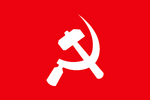More languages
More actions
Communist Party of India (Maoist) भारतीय कम्युनिस्ट पार्टी (माओवादी) ভারতের কমিউনিস্ট পার্টি (মাওবাদী) | |
|---|---|
 Flag | |
| General Secretary | Nambala Keshava Rao |
| Founded | 21 September 2004 |
| Banned | 2009 |
| Student wing | All India Revolutionary Students Federation |
| Youth wing | Radical Youth League |
| Women's wing | Revolutionary Adivasi Women's Organisation |
| Political orientation | Marxism-Leninism-Maoism Anti-imperialism |
| Part of a series on |
| Communist parties |
|---|
| Part of a series on |
| Maoism in India |
|---|
 |
The Communist Party of India (Maoist), often called the Naxals, is a Marxist-Leninist-Maoist political party in India.[1] Its militant wing, the People's Liberation Guerrilla Army, is currently engaged in a protracted people's war with the Indian government. CPI (Maoist) remains the largest maoist party in India.
History[edit | edit source]
CPI (Maoist) was formed in 21st September 2004 by the merging of Maoist Communist Centre of India and Communist Party of India (Marxist–Leninist) People's War,
Membership[edit | edit source]
The minimum age for joining the CPI (Maoist) is 16 years. Capitalists cannot join the party unless they hand over their property and integrate with the masses.[2]
Structure[edit | edit source]
The highest body of the CPI (Maoist) is the All-India Party Congress, which is held once every five years. The party congress elects a presidium, which elects the Central Committee. When the party congress is not in session, the Central Committee is the highest organ of the party. The Central Committee elects the Politburo and its leader, the general secretary.
Below the national level, the CPI (Maoist) has state, divisional, sub-divisional, committees that meet once every three years and are composed of professional revolutionaries. Area conferences are held once every two years. The lowest committees are village, factory, and college committees.
Local day-to-day activities are organized by party cells with three to five members or two to three villages combined.[2]
References[edit | edit source]
- ↑ "CPI(ML) Naxalbari, CPI(Maoist) merge" (2014-05-01). The Hindu. Retrieved 2022-02-17.
- ↑ 2.0 2.1 Muppala Lakshmana Rao (2004). Party Constitution. [PDF]
